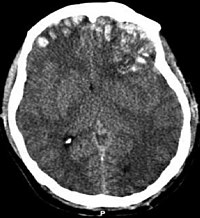
Photo from wikipedia
OBJECTIVES To conduct an economic evaluation of intracranial pressure (ICP) monitoring on the basis of current evidence from pediatric patients with severe traumatic brain injury, through a statistical model. METHODS… Click to show full abstract
OBJECTIVES To conduct an economic evaluation of intracranial pressure (ICP) monitoring on the basis of current evidence from pediatric patients with severe traumatic brain injury, through a statistical model. METHODS The statistical model is a decision tree, whose branches take into account the severity of the lesion, the hospitalization costs, and the quality-adjusted life-year for the first 6 months post-trauma. The inputs consist of probability distributions calculated from a sample of 33 surviving children with severe traumatic brain injury, divided into two groups: with ICP monitoring (monitoring group) and without ICP monitoring (control group). The uncertainty of the parameters from the sample was quantified through a probabilistic sensitivity analysis using the Monte-Carlo simulation method. The model overcomes the drawbacks of small sample sizes, unequal groups, and the ethical difficulty in randomly assigning patients to a control group (without monitoring). RESULTS The incremental cost in the monitoring group was Mex$3,934 (Mexican pesos), with an increase in quality-adjusted life-year of 0.05. The incremental cost-effectiveness ratio was Mex$81,062. The cost-effectiveness acceptability curve had a maximum at 54% of the cost effective iterations. The incremental net health benefit for a willingness to pay equal to 1 time the per capita gross domestic product for Mexico was 0.03, and the incremental net monetary benefit was Mex$5,358. CONCLUSIONS The results of the model suggest that ICP monitoring is cost effective because there was a monetary gain in terms of the incremental net monetary benefit.
Journal Title: Value in health regional issues
Year Published: 2017
Link to full text (if available)
Share on Social Media: Sign Up to like & get
recommendations!